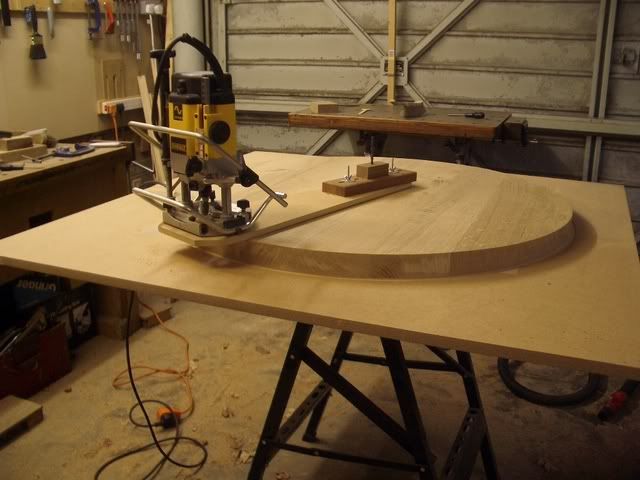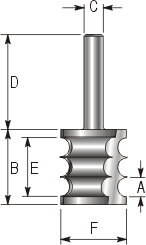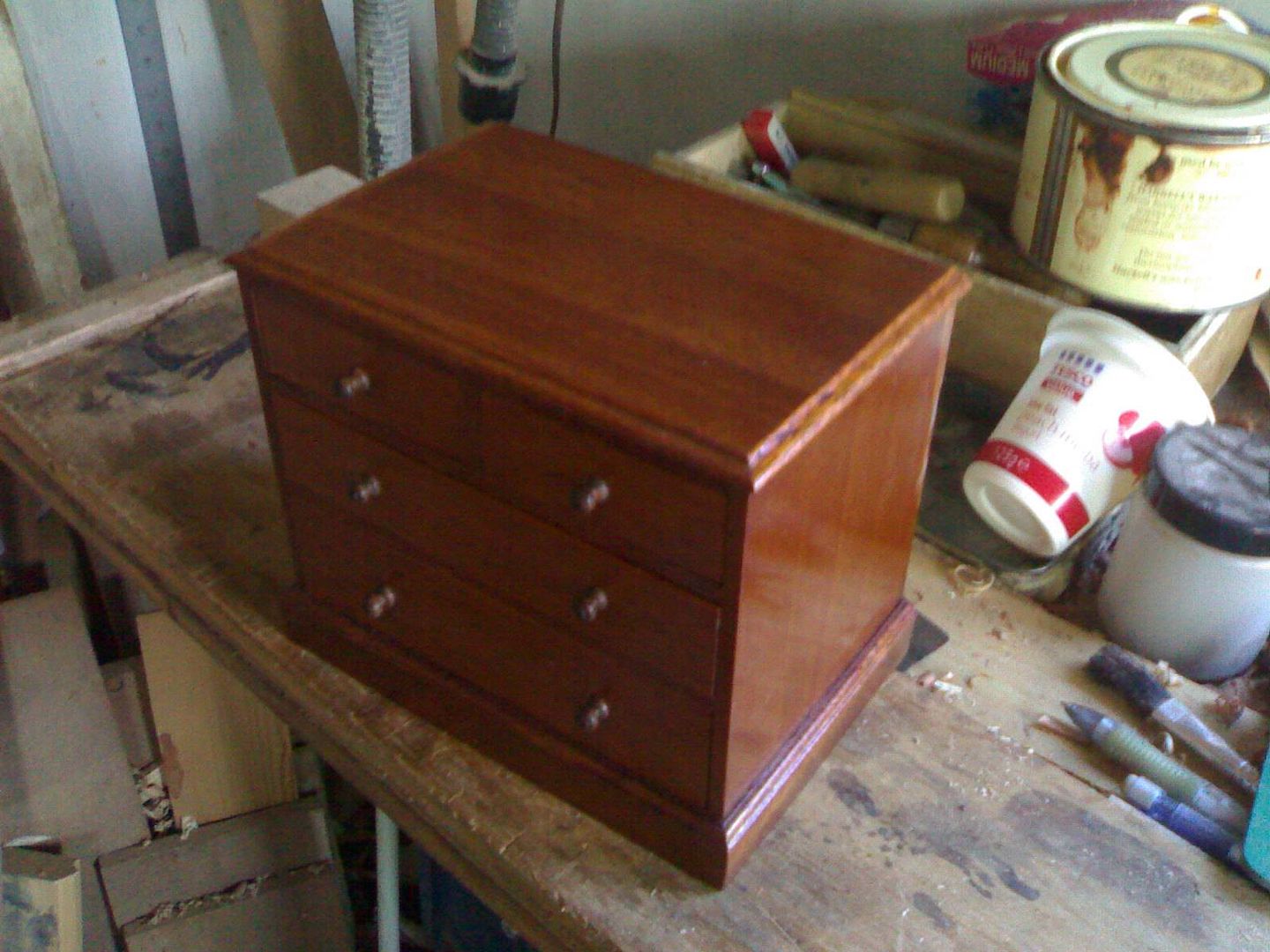|
|
Post by craigmarshall on Feb 22, 2008 19:11:28 GMT
Aggh. Mahogany and stain again. I hate the stuff. My boss has a friend that has a scabby old oval drop leaf table that needs converting to a solid circular table. He suggested using the wood from the existing table top, and the customer agreed, so he's passed it on to me to do. Anyway, I'll show you the pics from day one. Here it is before any modifications. The top is 3ft across and the legs from widest point to widest point are 3ft:  There's a small bit of stringing that is about 1mm deep. Have to plane that off:  Remove and dismantle the top:  Cut off the parts that don't interest me:  I saw this number in the bottom of the table, I guess it was a production run number or something. I know it's not an antique or anything, but I thought it would be nice to leave the number on the underside of the finished table top:  After thicknessing (to remove stringing and banding):  After jointing and gluing up:  Finished! (Not really ;D):  I superglued a block to the top, and made myself a small trammell to pass through the jigsaw base where the rip fence is supposed to go. It was so tight a fit I didn't need a bolt, but I used one anyway:  These makita battery jigsaws are the bees knees:  After a bit of a sand:  The routed edge:  Practicing with the colour, using "dark oak" and "v mahogany" again:  Turns out it wasn't quite perfectly round, so tuning it with an old compass plane. I find it's easier to use these if you push right at the mouth with both hands, not one front and back. Also - set the radius to slightly larger than the curved surface, so it rocks a little. Makes things much easier, I think:  And after two or three coats of stain:  It's had about five coats of liberon finishing oil (no pics of that yet, I'm afraid). I still need to clean up the base (and finish fixing the joints) and then refix the top to the bottom. More pics next week. Cheers, Craig |
|
|
|
Post by dom on Feb 22, 2008 19:39:29 GMT
Good work Craig.
|
|
|
|
Post by craigmarshall on Feb 22, 2008 19:47:40 GMT
Thanks. I don't really like this kind of work (bodging someone elses bodge), but I thought I'd put pics up anyway. I don't think the colours will match that well, but it will look better after a couple of years of use. (i.e throw the keys down on it a hundred times and move a vase around on it etc.), then it might not look as "new". Craig |
|
|
|
Post by paulchapman on Feb 22, 2008 22:27:48 GMT
That's excellent work, Craig. Cheers  Paul |
|
|
|
Post by johnboy on Feb 23, 2008 6:57:53 GMT
Looks good Craig, I like this sort of job myself, always find it interesting to see how stuff is put together.
Why did you use a jigsaw and not a router to cut the circle?
John
|
|
|
|
Post by craigmarshall on Feb 23, 2008 7:49:42 GMT
Why did you use a jigsaw and not a router to cut the circle? That's a good question. My boss recommended I use a router too, but for some reason I'm just a bit more comfortable with a jigsaw. So far, I've probably made more mistakes using a router than all the other tools put together. And I'm probably not doing myself any favours by shying away from them! As I think about it now, I think part of my problem with routers comes from the fact that each of the ones I/we use works in a slightly different way - i.e. fine fence adjuster winds the opposite way, etc. Cheers, Craig |
|
|
|
Post by paulchapman on Feb 23, 2008 10:37:28 GMT
I would have used a router as well. The problem with jigsaws is that they have a relatively thin blade that is unsupported for much of its travel and if the wood had been much thicker or harder there would have been the risk of a wonky (technical term ;D) cut. I would also recommend the use of a Plungebar for this sort of thing. It enables you to plunge the router single-handed and very smoothly - although it's helpful to have a router permanently set up with one fitted if you are going to do a lot of this stuff, because putting it on and taking it off is a bit of a faff  Cheers  Paul |
|
|
|
Post by 9fingers on Feb 23, 2008 12:19:09 GMT
Hi Craig,
I'm intrigued by the use of superglue to attach the centre block for the circle cutting operation on what looked to be the top surface (no screw telltales visible from the old layout).
I'm familiar with superglue/loctite in metal work as a temporary glue where I use heat to break it down. most anerobic adhesives let go at 300 degrees C or thereabouts.
However with wood, heat would not be sensible so presumably you broke it off with a persuader? Isn't there a risk of damaging the wood?
I think I would have just put a small screw in from the bottom for the centre pivot or used hot melt glue which is not that strong.
I'm still learning about wood so I'm interested in the decision and in no way criticising.
Bob
|
|
|
|
Post by craigmarshall on Feb 23, 2008 12:32:11 GMT
Isn't there a risk of damaging the wood? Hi Bob, Superglue has very little shear strength, and I used very little of it. A small less than pea-sized blob in each corner of the square. When I was finished, a tiny tap sideways and no wood from either the table top or the mounting block was damaged. A quick sand later to get the glue residue off and you'd never have known anything was there. We use superglue for all sorts of jobs, and it's really handy stuff. Another interesting thing is that if you make wood filler from oak dust and superglue, it goes off almost instantly, barely enough time to mix it up and almost with a smoke cloud!  Try the same with brown oak dust though, and it stays workable for 15 minutes or more! Don't know why, but there's certainly a difference. Cheers, Craig |
|
|
|
Post by colincott on Feb 23, 2008 22:32:01 GMT
Nice job Craig I have done a few jobs like that myself but they have been Antique  Can be fun  I have to add that if you get the chance to use some good quality mahogany, you might get to like using it a bit more. Unlike that sapele which is what that top is made from  |
|
|
|
Post by jfc on Feb 23, 2008 22:52:42 GMT
Pic 10 looks like a router was used  Jigsaws IMHO are rubbish as soon as they hit straight grain and should only be used for rough cutting . Still all your work looks good and its good that your boss lets you find your own way rather than telling you what tools you have to use . |
|
|
|
Post by craigmarshall on Feb 23, 2008 23:17:06 GMT
Pic 10 looks like a router was used  Jigsaws IMHO are rubbish as soon as they hit straight grain and should only be used for rough cutting . If you're looking at the pic I think you are, there's a white area which is 2/3rds of the thickness of the table? If so, that's the rebate and powdery crystallised glue that was holding on the triple bead let into the edge of the table... This kind of profile on the outside:  ... and a kind of curved tongue and groove on the inside. The idea with rebating a piece in is, I presume, that you can more easily (or more reliably or cleanly) route something complicated into long grain than end grain. So they let a piece into the end grain of the central rectangular panel. Anyway - the glue, whatever it was, had let bits of the table top separate (!), and the dovetailed legs had come away from the central column, I wasn't impressed with it at all! Was it cascamite? I have only seen this stuff once and I know it's made from a powder, which is why I ask. Thanks. He was away from the workshop that day so his influence was... minimised, shall we say ;D Craig |
|
|
|
Post by craigmarshall on Feb 23, 2008 23:19:38 GMT
I have to add that if you get the chance to use some good quality mahogany, you might get to like using it a bit more. Unlike that sapele which is what that top is made from  Ah! So it's not proper! How do you tell the difference? I do have some alleged real mahogany which I've made some guitar neck blanks from in preparation for building an electric guitar. I must get on with that project. I'd love to know how to tell the difference between all the mahogany lookalikes though. Cheers, Craig |
|
|
|
Post by craigmarshall on Feb 23, 2008 23:25:32 GMT
I would have used a router as well. Ah well - I know what to do next time. Yes - I know exactly what you mean. Also I had a less than perfect trammel bar (or whatever it is called). It itself was a bit flexi, and wasn't stopping the jigsaw from steering it's own course. (or even holding it vertical). So in effect, I was mostly steering with a bit of help. I knew in the back of my mind that I could fall back to the compass plane if needed though (and it was needed). Next time I'll use the router and a big straight bit and hopefully I'll get to a good result in less time. I've seen that somewhere on the internet before, but not in real life - I'd like to see a real life demo to be convinced, but a personal recommendation helps too! I think I had the impression that they were expensive, but I'll look them up again. Thanks Paul, Craig |
|
|
|
Post by paulchapman on Feb 24, 2008 10:54:25 GMT
I've seen that somewhere on the internet before, but not in real life - I'd like to see a real life demo to be convinced, but a personal recommendation helps too! I think I had the impression that they were expensive, but I'll look them up again. There's a demo video clip on the Woodrat site www.woodrat.com/plungebars.htmlThey sell different ones to fit different styles of router. That one that fits easiest is the one for the DeWalt 625/Elu 177E (you just need to remove the handles from the router) - some of the others are a bit of a performance to fit. Some people leave them on all the time but I only fit it when I need it. Cheers  Paul |
|






















 Try the same with brown oak dust though, and it stays workable for 15 minutes or more! Don't know why, but there's certainly a difference.
Try the same with brown oak dust though, and it stays workable for 15 minutes or more! Don't know why, but there's certainly a difference.



